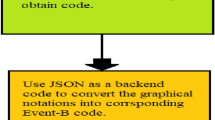Abstract
In this paper we show how state-of-the art SMT-based techniques for software verification can be employed in the verification of event–condition–action rules in intelligent environments. Moreover, we exploit the specific features of intelligent environments to optimise the verification process. We compare our approach with previous work in a detailed evaluation section, showing how it improves both performance and expressivity of the language for event–condition–action rules.













Similar content being viewed by others
References
Barrett C, Stump A, Tinelli C, Boehme S, Cok D, Deharbe D, Dutertre B, Fontaine P, Ganesh V, Griggio A, Grundy J, Jackson P, Oliveras A, Krstiäg S, Moskal M, Moura LD, Sebastiani R, Cok TD, Hoenicke JC (2010) The SMT-LIB standard: version 2.0. In: Technical report, Department of Computer Science, The University of Iowa
Berndtsson M, Mellin J (2009) ECA rules, pp 959–960. Springer, Boston. doi:10.1007/978-0-387-39940-9_504
Beyer D, Stahlbauer A (2014) BDD-based software verification. Int J Softw Tools Technol Transf 16(5):507–518. doi:10.1007/s10009-014-0334-1
Beyer D, Wendler P (2012) Algorithms for software model checking: predicate abstraction vs. impact. In: 2012 formal methods in computer-aided design (FMCAD), pp 106–113
Bryant RE (1986) Graph-based algorithms for Boolean function manipulation. IEEE Trans Comput 35(8):677–691. doi:10.1109/TC.1986.1676819
Cano J, Delaval G, Rutten E (2014) Coordination models and languages. In: 16th IFIP WG 6.1 international conference, coordination 2014, held as part of the 9th international federated conferences on distributed computing techniques, DisCoTec 2014, Berlin, 3–5 June 2014. Proceedings, chapter Coordination of ECA rules by verification and control, pp 33–48. Springer, Berlin. doi:10.1007/978-3-662-43376-8_3
Corradini F, Culmone R, Mostarda L, Tesei L, Raimondi F (2015) A constrained ECA language supporting formal verification of WSNs. In: 29th IEEE international conference on advanced information networking and applications workshops, AINA 2015 workshops, Gwangju, 24–27 March 2015, pp 187–192. doi:10.1109/WAINA.2015.109
De Moura L, Bjørner N (2008) Z3: an efficient SMT solver. In: Proceedings of the theory and practice of software, 14th international conference on tools and algorithms for the construction and analysis of systems, TACAS’08/ETAPS’08, pp 337–340. Springer, Berlin. http://dl.acm.org/citation.cfm?id=1792734.1792766
De Moura L, Bjørner N (2009) Satisfiability modulo theories: an appetizer. In: Brazilian symposium on formal methods, pp 23–36. Springer, New York
Delaval G, Rutten E, Marchand H (2013) Integrating discrete controller synthesis into a reactive programming language compiler. Discrete Event Dyn Syst 23(4):385–418. doi:10.1007/s10626-013-0163-5
Dijkstra EW (1975) Guarded commands, nondeterminacy and formal derivation of programs. Commun ACM 18(8):453–457. doi:10.1145/360933.360975
Dumas M, Hofstede AHMT (2001) UML activity diagrams as a workflow specification language. In: Proceedings of the fourth international conference on the unified modeling language, modeling languages, concepts, and tools. Springer, London, pp 76–90. http://dl.acm.org/citation.cfm?id=647245.719456
Ericsson A (2009) Enabling tool support for formal analysis of ECA rules. Ph.D. thesis, University of Skövde
Gries D (1989) The science of programming. Monographs in computer science. Springer, New York
Gu T, Wang XH, Pung HK, Zhang DQ (2004) An ontology-based context model in intelligent environments. In: Proceedings of communication networks and distributed systems modeling and simulation conference, vol 2004, San Diego, pp 270–275
Jin X, Lembachar Y, Ciardo G (2013) Symbolic verification of ECA rules. In: Joint proceedings of the international workshop on petri nets and software engineering (PNSE’13) and the international workshop on modeling and business environments (ModBE’13), Milano, 24–25 June 2013, pp 41–59. http://ceur-ws.org/Vol-989/paper17.pdf
Lee WS, Lee SY, Lee KC (2007) Conflict detection and resolution method in WS-ECA framework. In: The 9th international conference on advanced communication technology, vol 1, pp 786–791. IEEE, New York
Marchand H, Bournai P, Borgne ML, Guernic PL (2000) Synthesis of discrete-event controllers based on the signal environment. Discrete Event Dyn Syst 10(4):325–346. doi:10.1023/A:1008311720696
Mostarda L, Marinovic S, Dulay N (2010) Distributed orchestration of pervasive services. In: 24th IEEE IAINA 2010, Perth, 13–20 April 2010, pp 166–173
Sun Y, Wang X, Luo H, Li X (2015) Conflict detection scheme based on formal rule model for smart building systems. IEEE Trans Hum Mach Syst 45(2):215–227. doi:10.1109/THMS.2014.2364613
Vannucchi C, Cacciagrano DR, Corradini F, Culmone R, Mostarda L, Raimondi F, Tesei L (2016) A formal model for event-condition-action rules in intelligent environments. In: Proceedings of the 11th international conference on intelligent environments, pp 56–65. doi:10.3233/978-1-61499-690-3-56
Whitmore A, Agarwal A, Da Xu L (2015) The internet of things—a survey of topics and trends. Inf Syst Front 17(2):261–274. doi:10.1007/s10796-014-9489-2
Yoon JP (1989) Techniques for data and rule validation in knowledge based systems. In: Computer assurance, 1989. In: Proceedings of the fourth annual conference on COMPASS ’89, ’systems integrity, software safety and process security’, pp 62–70. doi:10.1109/CMPASS.1989.76042
Zhang J, Moyne J, Tilbury D (2008) Verification of ECA rule based management and control systems. In: 2008 IEEE international conference on automation science and engineering, pp 1–7. doi:10.1109/COASE.2008.4626431
Author information
Authors and Affiliations
Corresponding author
Rights and permissions
About this article
Cite this article
Vannucchi, C., Diamanti, M., Mazzante, G. et al. Symbolic verification of event–condition–action rules in intelligent environments. J Reliable Intell Environ 3, 117–130 (2017). https://doi.org/10.1007/s40860-017-0036-z
Received:
Accepted:
Published:
Issue Date:
DOI: https://doi.org/10.1007/s40860-017-0036-z




